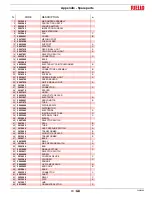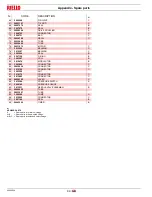
20096088
34
GB
Start-up, calibration and operation of the burner
5.8.3
Minimum gas pressure switch
The purpose of the minimum gas pressure switch is to prevent the
burner from operating in an unsuitable way due to too low gas pres-
sure.
Adjust the minimum gas pressure switch (Fig. 47) after having ad-
justed the burner, the gas valves and the gas train stabiliser. With
the burner operating at maximum output:
–
install a pressure gauge downstream of the gas train stabiliser
(for example at the gas pressure test point on the burner com-
bustion head);
–
choke slowly the manual gas cock until the pressure gauge de-
tects a decrease in the pressure read of about 0.1 kPa
(1 mbar). In this phase, verify the CO value which must always
be less than 100 mg/kWh (93 ppm).
–
Increase the adjustment of the gas pressure switch until it inter-
venes, causing the burner shutdown;
–
remove the pressure gauge and close the cock of the gas pres-
sure test point used for the measurement;
–
open completely the manual gas cock.
5.8.4
Low oil pressure switch
The low oil pressure switch is factory set to 261 PSI (18 bar).
If the oil pressure goes down this value in the delivery piping, the
pressure switch stops the burner.
Burner starts again automatically if the pressure goes above
261 PSI (18 bar) after burner start up.
5.8.5
High oil pressure switch
The high oil pressure switch is factory set to 43.5 PSI (3 bar).
If the oil pressure goes above this value in the return piping, the
pressure switch stops the burner.
Burner starts again automatically if the pressure goes down under
43.5 PSI (3 bar) after burner shut down.
If a loop circuit with Px pressure feeds the burner, the pressure
switch should be adjusted to Px + 43.5 PSI.
For the adjustment, (see Fig. 48).
WARNING
1 kPa = 10 mbar
Fig. 47
D9290
-
+
-
Fig. 48
D10627
















































